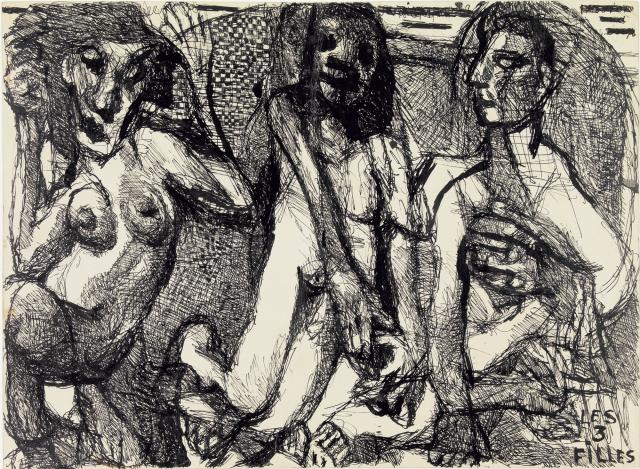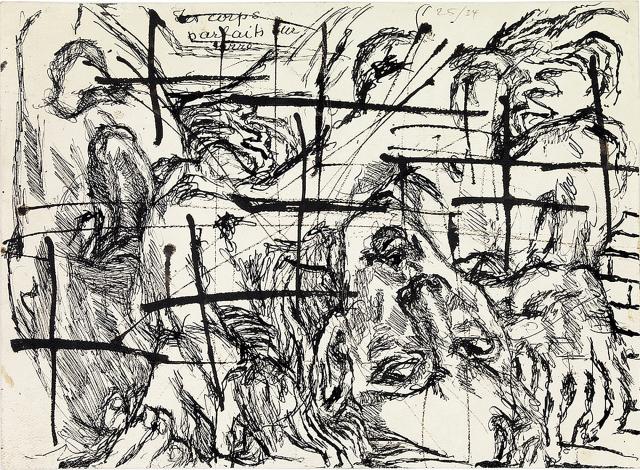Rather than planning out his subjects, Louis Soutter would trust to the initiative of the line, the chance effects born of tracing pen strokes repeatedly over one another, or the randomness of a stain occurring on the paper. “Every medium is grist to his mill…”, as René Auberjonois explained, “from the blue ink sold in the village where he is living, to the thick varnishes used in coachwork.” These media constituted so many opportunities to get clear of his academic training with a rare freedom of expression.
Les Trois Filles (recto), Trois têtes (verso) [Three Girls (front), Three Heads (back)] are the outcome of an obstinate repetition of crossed, hatched or superimposed pen strokes, a practice that is typical of his so-called mannerist period (1930 – 1936). Soutter, who was often short of drawing materials, would use each side of a sheet of paper, as he did here. Casting off figurative norms, he expresses through his drawing his profound suffering, which is echoed in the tension between his black and white hues. On the front of the sheet, three female figures are shown floating in a space devoid of perspective. Each represents a possible or fantasised attitude: seductive, introverted or distraught. Between intimidating woman and inhibited young girl, any harmony seems out of the question.
“I was dazzled by his immense, intense haunting and haunted work”, recalled Le Corbusier, a cousin of the artist, who tried to drum up interest in his drawings in Paris and the United States. In 1936 he described Soutter in these terms, “He has learned to look within. Through him, we can look inside a man. A distinguished, cultivated man, having gone through all the refined charms of money and an intelligent life. And who nowadays, coming back up from the sad canteen, at 65 years of age covers a blank sheet of paper day in day out with these harsh, powerful and admirable compositions.” Supported and encouraged by a small circle of friends that included René Auberjonois, Le Corbusier, Jean Giono and Charles-Ferdinand Ramuz, Soutter benefited from a few exchanges and outside points of view touching on his work despite his confinement.
Les Trois Filles (recto), Trois têtes (verso) [Three Girls (front), Three Heads (back)] are the outcome of an obstinate repetition of crossed, hatched or superimposed pen strokes, a practice that is typical of his so-called mannerist period (1930 – 1936). Soutter, who was often short of drawing materials, would use each side of a sheet of paper, as he did here. Casting off figurative norms, he expresses through his drawing his profound suffering, which is echoed in the tension between his black and white hues. On the front of the sheet, three female figures are shown floating in a space devoid of perspective. Each represents a possible or fantasised attitude: seductive, introverted or distraught. Between intimidating woman and inhibited young girl, any harmony seems out of the question.
“I was dazzled by his immense, intense haunting and haunted work”, recalled Le Corbusier, a cousin of the artist, who tried to drum up interest in his drawings in Paris and the United States. In 1936 he described Soutter in these terms, “He has learned to look within. Through him, we can look inside a man. A distinguished, cultivated man, having gone through all the refined charms of money and an intelligent life. And who nowadays, coming back up from the sad canteen, at 65 years of age covers a blank sheet of paper day in day out with these harsh, powerful and admirable compositions.” Supported and encouraged by a small circle of friends that included René Auberjonois, Le Corbusier, Jean Giono and Charles-Ferdinand Ramuz, Soutter benefited from a few exchanges and outside points of view touching on his work despite his confinement.

